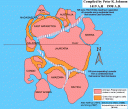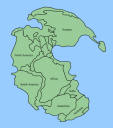If you’ve taught plate tectonics at the middle school level, you’re probably quite familiar with the supercontinent Pangaea. But did you know that Pangaea was not the only supercontinent in earth’s history – just the last to date? Millions of years before Pangaea, another supercontinent known as Rodinia united all of earth’s landmass in an unusual configuration. While we tend to think of Pangaea as the “starting point,” earth’s land and ocean basins have been continually shaped throughout geologic time through a supercontinent cycle.
While Pangaea certainly gets more press, Rodinia was the star of a recently published article in the July 11 edition of Science. As summarized in a National Science Foundation News release, John Goodge’s team was collecting geologic specimens in the Transantarctic Mountains when they discovered a single granite boulder atop Nimrod Glacier.
Andrew Barth (L) and Devon Brecke (R), collecting glacial moraine samples in the Miller Range of the Transantarctic Mountains. Photo courtesy of John Goodge, University of Minnesota.
Subsequent chemical and isotopic tests indicated that the boulder was strikingly similar to a belt of igneous rock running through the southwestern United States. These similar chemical and isotopic signatures provided support for the SWEAT (southwest United States East Antarctica) hypothesis, which states that East Antarctica was connected to the southwestern United States approximately one billion years ago, as part of the global supercontinent Rodinia.
The supercontinent Rodinia as it began to break up approximately 750 million years ago. Click on the image to see a larger version. Image courtesy of http://www.palaeos.com/Proterozoic/Proterozoic.htm.
At the heart of Rodinia was Laurentia, or the precursor to most of North America. Debate exists, however, on whether East Antarctica, Australia, Siberia, or South China fit with the western margin of Laurentia. This geologic discovery provides three lines of evidence in support of an East Antarctica – Laurentia connection.
Researchers theorize that about 600-800 million years ago, a portion of Rodinia broke away, gradually drifting southward to become eastern Antarctica and Australia. This movement just predates the Cambrian explosion, a rapid diversification of life and sudden appearance of complex organisms. Goodge explains that “there are ideas developing about these connections between the geo-tectonic world on the one hand and biology on the other.” It is possible that the shifting and colliding of continents, erosion, and influx of minerals and chemicals into the ocean may have provided nutrients to support a growing diversity of organisms.
Connecting to the National Science Education Standards
As with a discussion of Pangaea or plate tectonics in general, this article provides an opportunity to meet the Earth and Space Science standard’s various concepts. According to the National Science Education Standards, “The idea of systems provides a framework in which students can investigate the four major interacting components of the earth system – geosphere, hydrosphere, atmosphere, and the biosphere. In this holistic approach to studying the planet, physical, chemical, and biological processes act within and among the four components on a wide range of time scales to change continuously earth’s crust, oceans, atmosphere, and living organisms.” The holistic approach described in the NSES is reflected in this study’s use of geologic evidence to explain an important biological phenomenon.
How to Turn This News Event into an Inquiry-Based, Standards-Related Science Lesson
Rather than spark a new lesson, this current event provides an opportunity to revisit a familiar unit on plate tectonics, geologic time, and rocks and minerals. Most teachers include a discussion of Alfred Wegner and the evidence for his theory of plate tectonics, including similar fossilized plants and reptiles found in South America and Africa.
After students understand how Wegner used geologic and fossil evidence to reconstruct Pangaea, present the evidence from this most recent discovery. Ask them to explain how the same type of granite could be found in eastern Antarctica and the southwest United States. Once students conclude that the two continents must have been connected, re-examine a diagram of Pangaea, which shows an African-Antarctic connection, not a North America-Antarctic one. How, then, could these two places have similar rocks?
A reconstruction of the supercontinent Pangaea. Click on the image to see a larger version. Image courtesy of Kieff via Wikimedia.
Referring to geologic time may help at this point. Using a modified time scale, remind students that Pangaea existed approximately 200 million years ago, while earth is approximately 4.6 billion years old. What did earth’s surface look like before Pangaea? Lead students to the conclusion that other supercontinents, like Rodinia, existed well before Pangaea. Introduce the concept of the supercontinent cycle.
This type of discussion naturally progresses to the mechanics and processes driving the cycle: plate movement. The following resources from the Middle School Portal can help you teach about earth’s interior and plate tectonics. It may also be helpful to brush up on concepts related to geologic time, as these processes span millions of years.
Geologic Time: Eons, Eras, and Epochs
http://msteacher.org/epubs/science/science16/science.aspx
Plate Tectonics: Moving Middle School Science
http://msteacher.org/epubs/science/science1/science.aspx
Once students understand plate interactions (rifting, subduction, sea-floor spreading), take a global view. Using a world map, plot the locations of plate divergence and convergence. Challenge students to predict what the next supercontinent will look like. For example, current plate movement indicates that as the Atlantic Ocean basin grows, the Pacific Ocean basin is shrinking. In the future, western North America may be connected to Asia in the earth’s latest supercontinent.
Introducing Rodinia as part of a greater supercontinent cycle presents plate tectonics as a driving force in a long-term pattern of constructive and destructive forces. It provides another opportunity for students to consider the cyclic change: a fundamental principle in science.
We Need Your Help
We want and need your ideas, suggestions, and observations. What would you like to know more about? What questions have your students asked? Do you have a favorite activity that you would like to share? We invite you to share with us and other readers by posting your comments. Please check back each week for our newest post or download the RSS feed for this blog. You can also request email notification when new content is posted (see right navigation bar).
Let us know what you think and tell us how we can serve you better. We want your feedback on all of the NSDL Middle School Portal science publications. Email us at msp@msteacher.org.





Thanks for informing us further on Rodinia and its history.
When the continents were merged together, as with Pangaea, Rodinia, Columbia,etc., how did this affect the overall seafloor?
Assuming the ocean was much larger than it is today, was the sea level much lower and how did this affect the climate?